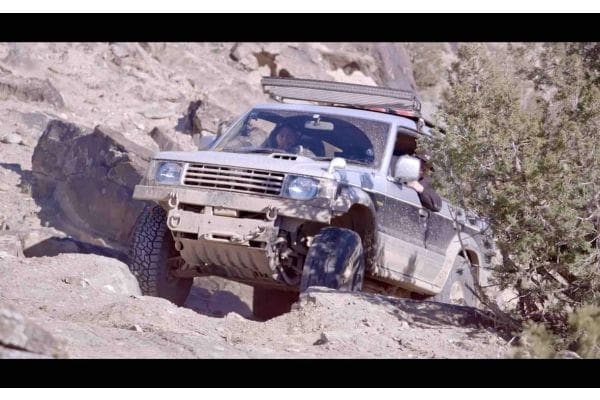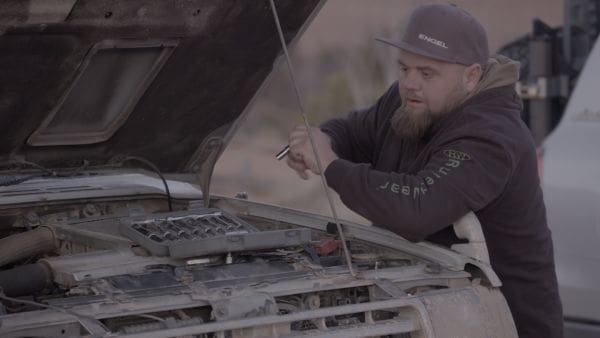Overlanding on a Budget Feat. Crew from “Overlanders” TV Series on Outdoor Channel

“Budget” and “Overlanding” usually don’t go in the same sentence. But master mechanics, Fred Ashmore and Billy Taff beg to differ. Recently, they competed on the hit series, “Overlanders,” which is airing now on Fridays at 8:30 p.m. ET on Outdoor Channel. Their vehicle of choice was a 1993 Mitsubishi Pajero they found abandoned in a yard. And that’s when the real work began for the two competitors.
“I love four-wheeling, camping and overlanding – putting all of these together is the best thing ever,” shared Taff.
“We wanted to do a budget build. And if we can do it in this, then pretty much anybody can do overlanding in anything,” stated Ashmore.
What, exactly, did it take for this build to come together? And can anyone truly do this? We caught up with Ashmore and Taff and asked them the tough questions.
Q: Why this vehicle? What is so special or unique about the Pajero that you saw potential for the build?
BT: Finding the Pajero was a great coincidence. We were searching for something one off. Fred had run across it at the same time he was working on another car deal. The Pajero is unique in the fact that it is a Japanese imported, right hand drive version of the Mitsubishi Montero. It’s counterparts we have in the USA, except that it was outfitted with a diesel engine, and a stronger drivetrain. I wanted something with enough room to hold all our gear, a fuel injected engine, and was proven to be reliable. The Pajero checked all these boxes.
FA: I have always worked best under pressure, the tougher the build or deadline, the more focused I am. There’s always been a uniqueness in my personality to think outside the box and the Pajero not only fits into that, it also is well known for its off-road performance in events such as the Dakar Rally. We were lucky enough to find this old Pajero in a field that was imported for a rural mail route. When I told the owner what I wanted to do with her old mail buggy, she was willing to donate it to the cause. It was a perfect fit for us, budget-wise, and to showcase an underdog team with a unique vehicle on a budget.
Q: How much money did you sink into the re-build? (Approximately)
BT: Altogether we had about $3000 in the build. The body lift front differential locker and tires were the most expensive. Everything else was literally from our scrap iron piles. The body lift was from a Chevy suburban off Facebook Marketplace. Fred modified it to fit the Pajero. This was how we went about the whole build, if we couldn’t buy it, we made it.
Q: How did you source the items needed? Especially for a vehicle that is 20-years old?
BT: Well, the vehicle’s age was not a factor. Generally, within reason older vehicles are cheaper to build.
FA: This is one of my expertise I grew up doing, building what I need with whatever I must work with. Billy and I share that trait and I believe that’s why we mesh so well as a team. Most of the build was sourced from old vehicles here at my property in Oklahoma and Maine. The Old 8275 Warn winch was on an old oilfield truck. The metal straps and C channel for the bumpers were from an old house trailer frame, and the rack on the roof was built from stadium bleachers and commercial van racks. The “built in” was made from 2×10’s ripped down, that used to be shelves in a bus used for storage. The lift was made from a Dodge pickup body lift I bought for $20 with the torsion bars turned all the way up. We used a CO2 canister from a restaurant soda dispenser for our onboard air. The hardest part to find was the ARB front locker which we almost didn’t get. The remaining camping gear was purchased via Facebook Marketplace or by Billy to use with his family this summer.
Q: What would you recommend to someone considering re-building a vehicle specifically for overlanding?
BT: Buy something sold in the USA. Even though we have the Montero in the United States, we found that they did not share many interchangeable parts.
FA: I’d recommend staying within your comfort zone and ability. Overlanding is a balance of capability and reliability. If you’re capable of fixing what you have in the middle of nowhere enough to get you back to common resources, go for it. If you don’t have those capabilities, then you really must find where your budget meets with your capabilities to determine reliability. There are great reliable inexpensive vehicles out there to build on a budget, being unique can come at a price if your capabilities don’t meet your rig’s reliability. Mother Nature doesn’t discriminate when it comes to how much you do or don’t spend.
Q: Where is PJ now?
FA: I daily drive it and I mean every day. I recently sold my F-150 and purchased an SUV for my wife. We have two rescue dogs and they love to ride in the Pajero through town or take my son to school or work. It’s really enjoyable and draws a lot of attention being diesel and right-hand drive.
Q: What DON’T you need in an overland vehicle that everyone says is a “must-have?”
BT: A rooftop tent, or a refrigerator.
FA: A rooftop tent. They’re expensive and unnecessary. To me it’s more of a niche cliche expense, which is money that can afford you a lot more important/usable item for overlanding.
Q: If folks are new to overlanding, what resources can you suggest they watch, listen, read?
BT: Honestly, I feel that people plan too much and never get much accomplished. Stop reading and stop watching YouTube videos. Go get a sleeping bag, food, fishing pole and load up in your vehicle. Download onX Offroad pick a trail that fits your comfort level and go have some fun. Camp out and enjoy the outdoors. You will learn along the way what you want or need to take with you. You just have to start somewhere.
FA: Overlanding for Poors is a Facebook group which has a lot of entry level advice and experience from longtime overlanders. Also join groups related to vehicles you’re considering to determine pros/cons and expensive repairs.
Q: Who is the better mechanic?
BT: Fred, being a Ford guy, makes him a better mechanic by default.
FA: There’s no such thing as a better mechanic. A good team offsets each other’s abilities when it comes to approaching tasks or repairs. It’s as important to know what part or wrench to hand a mechanic as it is for that mechanic to know what’s wrong. Billy and I have a balance and work ethic I believe is unmatched on the show regardless of who we were competing with.
Q: What did you wish someone told you when you first started overlanding?
BT: Wheel for the week not the day. And by that, I mean cautiously drive your vehicle so you can make it throughout the week and not break it on the first obstacle you come to. After all you’re overlanding not rock crawling.
FA: Listen to people who’ve done it in ANY capacity. When you stop listening you stop learning. None of us know everything and sometimes some of the best ideas or knowledge come from people you’d least expect it. I learned this at a young age and it’s the biggest asset to anything I do.


